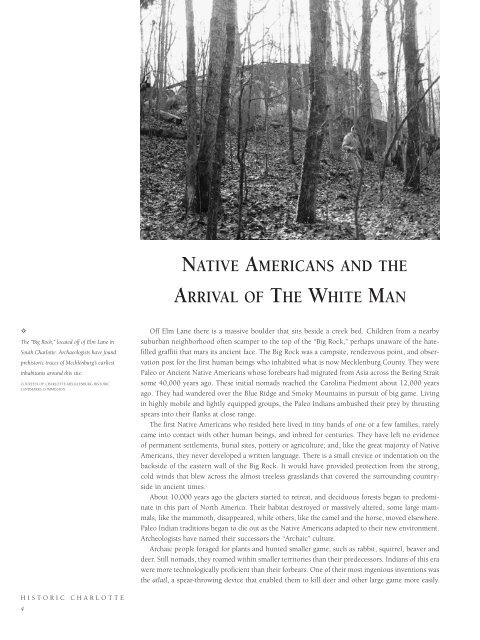Historic Charlotte
An illustrated history of the City of Charlotte and the Mecklenburg County area, paired with the histories of companies, families and organizations that make the region great.
An illustrated history of the City of Charlotte and the Mecklenburg County area, paired with the histories of companies, families and organizations that make the region great.
You also want an ePaper? Increase the reach of your titles
YUMPU automatically turns print PDFs into web optimized ePapers that Google loves.
NATIVE AMERICANS AND THE<br />
ARRIVAL OF THE WHITE MAN<br />
✧<br />
The “Big Rock,” located off of Elm Lane in<br />
South <strong>Charlotte</strong>. Archaeologists have found<br />
prehistoric traces of Mecklenburg’s earliest<br />
inhabitants around this site.<br />
COURTESY OF CHARLOTTE-MECKLENBURG HISTORIC<br />
LANDMARKS COMMISSION.<br />
Off Elm Lane there is a massive boulder that sits beside a creek bed. Children from a nearby<br />
suburban neighborhood often scamper to the top of the “Big Rock,” perhaps unaware of the hatefilled<br />
graffiti that mars its ancient face. The Big Rock was a campsite, rendezvous point, and observation<br />
post for the first human beings who inhabited what is now Mecklenburg County. They were<br />
Paleo or Ancient Native Americans whose forebears had migrated from Asia across the Bering Strait<br />
some 40,000 years ago. These initial nomads reached the Carolina Piedmont about 12,000 years<br />
ago. They had wandered over the Blue Ridge and Smoky Mountains in pursuit of big game. Living<br />
in highly mobile and lightly equipped groups, the Paleo Indians ambushed their prey by thrusting<br />
spears into their flanks at close range.<br />
The first Native Americans who resided here lived in tiny bands of one or a few families, rarely<br />
came into contact with other human beings, and inbred for centuries. They have left no evidence<br />
of permanent settlements, burial sites, pottery or agriculture; and, like the great majority of Native<br />
Americans, they never developed a written language. There is a small crevice or indentation on the<br />
backside of the eastern wall of the Big Rock. It would have provided protection from the strong,<br />
cold winds that blew across the almost treeless grasslands that covered the surrounding countryside<br />
in ancient times.<br />
About 10,000 years ago the glaciers started to retreat, and deciduous forests began to predominate<br />
in this part of North America. Their habitat destroyed or massively altered, some large mammals,<br />
like the mammoth, disappeared, while others, like the camel and the horse, moved elsewhere.<br />
Paleo Indian traditions began to die out as the Native Americans adapted to their new environment.<br />
Archeologists have named their successors the “Archaic” culture.<br />
Archaic people foraged for plants and hunted smaller game, such as rabbit, squirrel, beaver and<br />
deer. Still nomads, they roamed within smaller territories than their predecessors. Indians of this era<br />
were more technologically proficient than their forbears. One of their most ingenious inventions was<br />
the atlatl, a spear-throwing device that enabled them to kill deer and other large game more easily.<br />
HISTORIC CHARLOTTE<br />
4
















